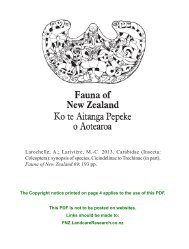PDF File - Landcare Research
PDF File - Landcare Research
PDF File - Landcare Research
Create successful ePaper yourself
Turn your PDF publications into a flip-book with our unique Google optimized e-Paper software.
Gorse colonial hard shoot moth (Pempelia genistella)<br />
Late spring, before plants put on new growth, is the<br />
best time to check release sites as the green-andbrown<br />
striped caterpillars and their webs are at their<br />
largest. Please let us know if you fi nd any, anywhere,<br />
as we still have only confi rmed establishment at a<br />
few sites in Canterbury.<br />
If you can fi nd the webs in good numbers, harvest<br />
infested branches and move these to new sites as<br />
help is needed to increase the moth’s distribution.<br />
Late spring is the best time, when large caterpillars<br />
or pupae are present.<br />
Green thistle beetles (Cassida rubiginosa)<br />
Check release sites for adult beetles, which emerge<br />
on warm days towards the end of winter and feed on<br />
new thistle leaves making round window holes. The<br />
adults are 6–7.5 mm long and green, but are quite<br />
well camoufl aged against the leaf. The larvae also<br />
make windows in the leaves. They have prominent<br />
lateral and tail spines and a protective covering of old<br />
moulted skins and excrement.<br />
Beetles may have built up to harvestable numbers<br />
at some of the oldest sites so it may be possible<br />
to begin redistribution. Use a garden-leaf vacuum<br />
machine and aim to shift at least 50 adults in the<br />
spring. Be careful to separate the beetles from other<br />
material collected during the vacuuming process,<br />
which may include pasture pests.<br />
Ragwort crown-boring moth (Cochylis atricapitana)<br />
No signs of establishment of this moth have been<br />
seen yet so it would be good to check release<br />
sites one last time. Look for rosettes with damaged<br />
centres and black frass or thickened stems and<br />
bunched leaves. If present the caterpillars should be<br />
most easily found by pulling apart damaged plants<br />
during August–September. They are creamy-white,<br />
with black heads that become brown when they are<br />
older, and are quite short and fat.<br />
Ragwort plume moth (Platyptilia isodactyla)<br />
October is the best time to check release sites for<br />
caterpillars. Look for plants with wilted or blackened<br />
or blemished shoots with holes and an accumulation<br />
of debris, frass or silken webbing. Pull back the<br />
leaves at the crown of damaged plants to look for<br />
large hairy, green larvae and pupae. Also check<br />
where the leaves join bolting stems for holes and<br />
frass. Don’t get mixed up with blue stem borer larvae<br />
Woolly nightshade lace bug adults and juvenile.<br />
(Patagoniodes farinaria), which look similar to plume<br />
moth larvae until they develop their distinctive bluish<br />
colouration.<br />
If present in good numbers the best time to harvest<br />
this moth is in late spring. Dig up damaged plants,<br />
roots and all. Pupae may be in the surrounding soil<br />
so retain as much as possible. We recommend<br />
shifting at least 50–100 plants but the more the<br />
greater the chance the moth will establish. Place<br />
one or two infested plants beside a healthy ragwort<br />
plant at the release site so any caterpillars can crawl<br />
across.<br />
Tradescantia leaf beetle (Neolema ogloblini)<br />
Given that the fi rst releases only went out last<br />
autumn it may well be far too early to fi nd the beetle<br />
at release sites this spring, but no doubt some of<br />
you will be dying for a look anyway! The adults<br />
may be hard to spot as they tend to drop when<br />
disturbed. Look instead for the slug-like larvae in<br />
areas where there is damage to the leaves.<br />
Woolly nightshade lace bug (Gargaphia decoris)<br />
Lacebug releases only began last summer, but given<br />
the gregarious nature of these insects, and how well<br />
they did early on, it would be worth checking release<br />
sites as soon as the weather warms up. Look on<br />
the undersides of leaves for the adults and nymphs,<br />
especially on leaves showing signs of bleaching or<br />
black spotting around the margins.<br />
Send any reports of interesting, new or unusual sightings to<br />
Lynley Hayes (hayesl@landcareresearch.co.nz, Ph 03 321<br />
9694). Monitoring forms for most species can be downloaded<br />
from www.landcareresearch.co.nz/research/biocons/weeds/<br />
book/ under Release and Monitoring Forms.<br />
13
















